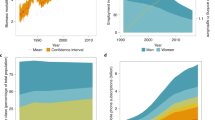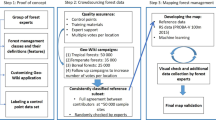Abstract
A novel European Union forest policy based on the best and most up-to-date information available is urgently needed. Without such change, forests will not provide the resources we need and will suffer heavily under climate change. Forest inventories and many information sources exist in all countries but are not properly used in European Union policymaking. We introduce a next-generation information tool that portrays a synchronized top-down European forest management strategies map, spatially weighing the multifunctionality of European forests.
This is a preview of subscription content, access via your institution
Access options
Access Nature and 54 other Nature Portfolio journals
Get Nature+, our best-value online-access subscription
$29.99 / 30 days
cancel any time
Subscribe to this journal
Receive 12 digital issues and online access to articles
$119.00 per year
only $9.92 per issue
Buy this article
- Purchase on Springer Link
- Instant access to full article PDF
Prices may be subject to local taxes which are calculated during checkout

Similar content being viewed by others
Data availability
For source data and all driver tables, see the supplementary information file. The data that support the findings of this study as well as the resulting map are available from the corresponding author upon request.
References
Proc. Ministerial Conference on the Protection of the Forests in Europe (ForestEurope, 1993); https://foresteurope.org/ministerial-conferencies/#1470845666254-7db11a98-dd1d7522-d58f
Updated Bioeconomy Strategy (European Commission, 2018); https://ec.europa.eu/research/bioeconomy/index.cfm?pg=policy&lib=strategy
Rockström, J. et al. Nature 461, 472–475 (2009).
Kovats, S. et al. in Climate Change 2014: Impacts, Adaptation and Vulnerability (eds Field, C. B. et al.) Ch. 23 (IPCC Cambridge Univ. Press, 2014).
Europa: mittlerweile über 100 mio fm schadholz angefallen. EUWID (12 November 2018); https://www.euwid-holz.de/news/rundholzschnittholz/einzelansicht/Artikel/europa-mittlerweile-ueber100-mio-fm-schadholz-angefallen.html.
Hlásny, T. et al. Living with Bark Beetles: Impacts, Outlook and Management Options (From Science to Policy 8, European Forest Institute, 2019).
Aggestam, F. & Pülzl, H. Forests 9, 125–144 (2018).
Legally binding agreement. Forest Europe News http://foresteurope.org/legally-binding-agreement2/ (2011).
Forest Europe Expert Level Meeting, 19–20 March 2019, Bratislava, Slovakia (Forest Europe, 2019); https://foresteurope.org/wp-content/uploads/2017/08/Summary_key-decisions-of-ELM1_2019_final.pdf
Regulation (EU) 2018/841 of the European Parliament and of the Council of 30 May 2018. Official Journal of the European Union L 156/1–L 156/25 (2018).
Proposal for a regulation of the European Parliament and of the Council on the establishment of a framework to facilitate sustainable investment COM (2018) 353 final (European Commission, 2018).
Directive (EU) 2018 /2001 of the European Parliament and of the Council of 11 December 2018. Official Journal of the European Union L 328/82–L 328/209 (2018).
European Parliament resolution of 20 April 2012 on our life insurance, our natural capital: an EU biodiversity strategy to 2020 (2011/2307(INI)) (2013/C 258 E/15). Official Journal of the European Union C 258 E/99–C 258 E/114 (2013).
Nabuurs, G. J. et al. Forests 8, 484–498 (2017).
State of Europe’s Forests 2015 (Forest Europe, FAO, EFI, 2015).
Kempeneers, P. et al. IEEE Trans. Geosci. Remote Sens. 49, 4977–4986 (2011).
IGN. L’if: IGN Mag.’s. Spec. Issue For. Inf. 32, 9–12 (2013).
Alberdi, I. et al. Policy Econ. 70, 20–29 (2016).
Schelhaas, M. J. et al. Forest Ecosyst. 5, 21–40 (2018).
Jensen, F. V. & Nielsen, T. D. Bayesian Networks and Decision Graphs (Springer, 2007).
Aguilera, P. A. et al. Environ. Model Softw. 26, 1376–1388 (2011).
Acknowledgements
This research was part of the PEGASUS project, which has received funding from the European Union’s Horizon 2020 (grant agreement no. 633814) and VERIFY (no. 776810). Co-financing was received from the System Earth Management Programme (KB-24-003-006) and the KB Circular Economy of the Ministry of Agriculture, Nature Management and Food Quality from the Netherlands. We thank N. Heidema and B. Lerink for the final version of the map. An initial assessment of the most recent damage by bark beetles in Europe was made by L. König (WUR) using the most recent data in regional and national statistics.
Author information
Authors and Affiliations
Contributions
G.-J.N. conceived the study and wrote most of the paper. P.V. carried out the BBN experiment and conceived most of the core of the BBN methods and wrote large parts of the supplementary information. M.V.E. gathered the GIS layers and wrote part of the supplementary information. M.P.-S. wrote parts of the main text. H.P. wrote parts of the main text. K.H. conceived parts of the study, carried out the BBN experiments and wrote parts of the main text.
Corresponding author
Ethics declarations
Competing interests
The authors declare no competing interests.
Additional information
Publisher’s note: Springer Nature remains neutral with regard to jurisdictional claims in published maps and institutional affiliations.
Supplementary information
Supplementary Information
Supplementary methods, Figs. 1–4, refs. 1–18 and Tables 1–9.
Rights and permissions
About this article
Cite this article
Nabuurs, GJ., Verweij, P., Van Eupen, M. et al. Next-generation information to support a sustainable course for European forests. Nat Sustain 2, 815–818 (2019). https://doi.org/10.1038/s41893-019-0374-3
Received:
Accepted:
Published:
Issue Date:
DOI: https://doi.org/10.1038/s41893-019-0374-3
This article is cited by
-
Assessing pollinator habitat suitability considering ecosystem condition in the Hannover Region, Germany
Landscape Ecology (2024)
-
Strategies and Barriers to Reconcile Pest Management with Insect Conservation in Temperate and Boreal Forests
Current Forestry Reports (2024)
-
EU-Trees4F, a dataset on the future distribution of European tree species
Scientific Data (2022)
-
Mechanised Harvesting of Broadleaved Tree Species in Europe
Current Forestry Reports (2022)
-
Bark Beetle Outbreaks in Europe: State of Knowledge and Ways Forward for Management
Current Forestry Reports (2021)



